Next webinars
Past webinars
2024
Monday, 15/01 (15h, CET)
Nuclear structure for high-energy nuclear physics,
Giuliano Giacalone (Heidelberg University, Germany)
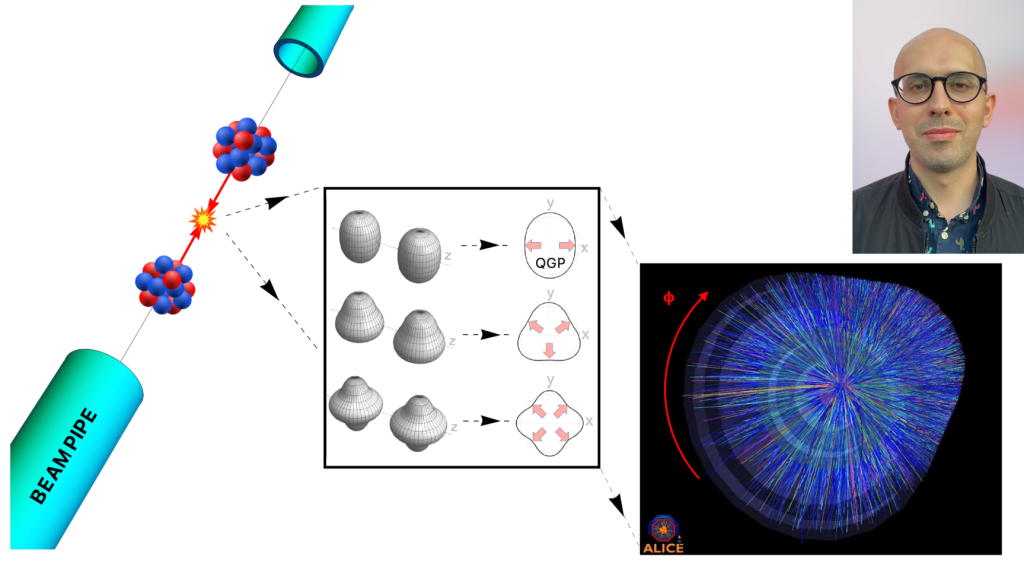
Nuclear collisions at ultra-relativistic energies enable us to study in the laboratory the quark-gluon plasma (QGP), the hot phase of strong-interaction matter that filled our Universe a few microseconds after the Big Bang. Recently, it has been realized that the output of these experiments is sensitive to the details of the spatial distributions of nucleons in the colliding ions. To make progress in understanding data, we have witnessed tremendous progress in matching notions from low-energy nuclear physics, such as nuclear deformations, to theoretical simulations of high-energy collisions.
In this seminar, I review the progress made and highlight recent results at the intersection of nuclear structure and high-energy collisions. I argue that these investigations have opened a new research direction in nuclear physics, and that issues opened by collider data have already lead to new advances in our understanding of nuclei. I discuss the prospects for future experimental and theoretical work on this subject from which the nuclear community as a whole could benefit.
2023
Monday, 18/12 (15h, CET)
Precise measurements of fission neutrino spectra,
David Lhuillier (CEA Irfu/SPhN)
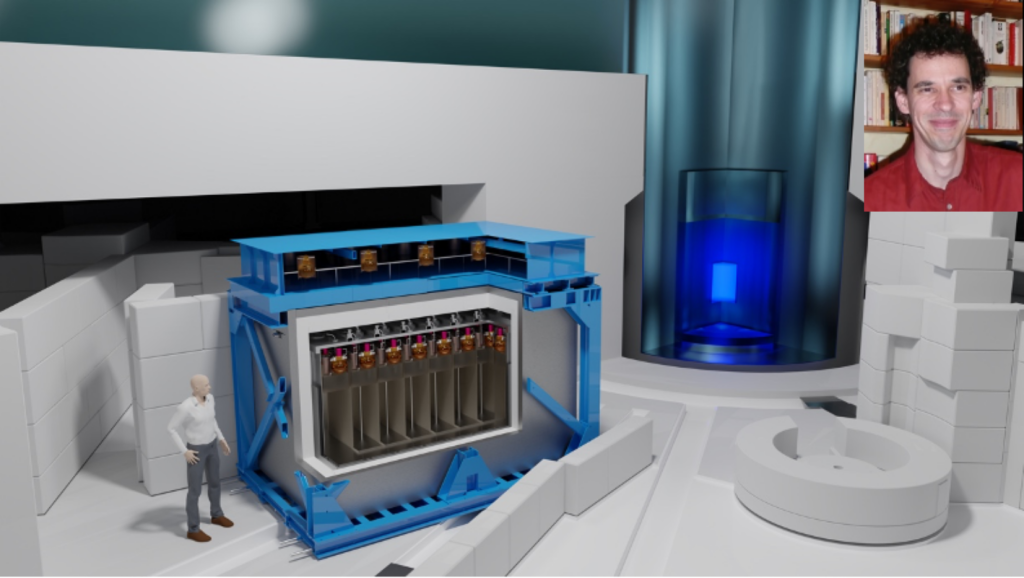
Neutrino physics is closely linked to nuclear reactors, as they are the most intense source of neutrinos controlled by man. After a brief historical review, we’ll see how nuclear data have fed neutrino experiments, firstly to bring out the rare interactions of these ghostly particles from the ambient background, and secondly to gain precision and measure neutrino oscillation parameters. We will present the STEREO experiment, which has just completed a study of oscillations at very short distance (10 m) from the ILL reactor in Grenoble, to test the hypothesis of a new type of neutrino, called sterile. We’ll see how this recent measurement turn the tables on nuclear data: fission as seen by neutrinos becomes precise enough to highlight the biases in nuclear databases of beta transitions, and thus serve as a reference to validate the re-evaluations currently underway.
Monday, 02/10 (15h, CET)
Probing the properties of dense matter with neutron stars,
Anthea Fantina (GANIL, France)
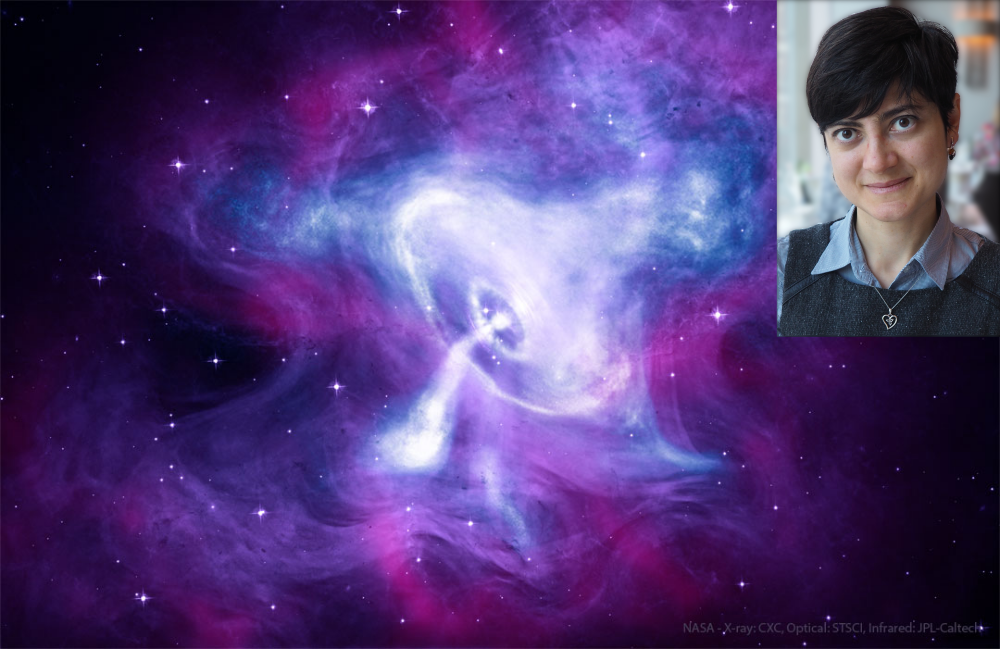
Neutron stars are unique laboratories to probe matter in extreme conditions that cannot be currently reproduced on Earth. Nuclear physics experiments, in tandem with astrophysical observations, can give valuable insight into the properties of dense matter encountered in these stellar objects.
The connection between astrophysical observations and microphysical properties of NSs requires both microscopic and macroscopic (global) modelling. For cold (mature), slowly rotating, and isolated neutron stars, this connection mainly relies on the knowledge of the equation of state.
In this presentation, I will give a brief introduction on the neutron-star physics, particularly focussing on the equation-of-state modelling, in connection with current constraints coming from nuclear-physics theoretical calculations and experiments, and I will discuss the link between neutron-star observations and modelling.
The prediction for neutron-star properties and observables obtained using different equations of state (with their associated uncertainties) will be also presented in relation with recent (multi-messenger) astrophysical observations.
Monday, 22/05 (15h, CET)
Nuclear Structure: from Neutron Halo to Tensor Forces,
Isao Tanihata (Osaka University, Japan)

Neutron halos have been discovered in extremely neutron rich nuclei and have been guiding us to a new world of nuclear structure. Traditional understanding of nuclear structures had to be changed by the appearances of not only the halo but also many other new phenomena such as neutron skin, soft mode of excitations and others.
Appearance of new magic numbers also is a novel discovery in nuclear structure in addition to the disappearance of the traditional magic numbers. It was believed that the magic numbers exist for protons and neutrons independently each other and intact. However new magic numbers appear in selected regions of proton and neutron number combinations. The proton and neutron magic numbers are not independent anymore. The disappearances occurs also in selected regions.
What is the reason why such changes of shell structure occurs? Is it due to the details of the structure dependence on the proton and neutron numbers or due to more global feature of the nuclear interactions?
The tensor force is known as basic interaction that make deuteron bound and also provides saturation properties of nuclear matter and nuclei but in somewhat complicated process namely the cross term of S- and D-wave including high-momentum nucleons. Probably because of the complication, tensor interaction had not been included explicitly for discussing the low-energy structure of nuclei. The tensor interactions have been treated under the assumption that they are folded in the mean field effectively. It may not produce large change of the shell structure as long as the tensor forces change the mean field in small amount and change smoothly with the number of nucleons. However this assumption may not be appropriate since 1: the total energy gained by the tensor force is really large in total, therefore a subtle change of tensor energy may be as large as the shell gap and 2: tensor force is very selective on the combination of proton and neutron and also on the spin-isospin state of combined pair of nucleons, thus the filling of an specific orbitals by a nucleon may change binding energy significantly.
Recently, a shell model that include the tensor interaction as the residual interaction has been introduced and succeed to explain some features of shell changes. However the effect from tensor forces is strongly related to the high-momentum or the highly-excited orbital of nucleons in nuclei. The present calculation does not include a high-momentum component except the exchange term, that effectively introduces a part of high-momentum effect.
The main subject of the talk is to show a global view of the relation between nucleon numbers in the various shells and changes of binding energies, that modify the shell structure. I will show that the same principle that provides the nuclear saturation explain the global change of the shell structure in nuclei.
Monday, 17/04 (15h, CET)
Advances and challenges in the ab initio description of the nuclear many-body problem
Thomas DUGUET (CEA Saclay)
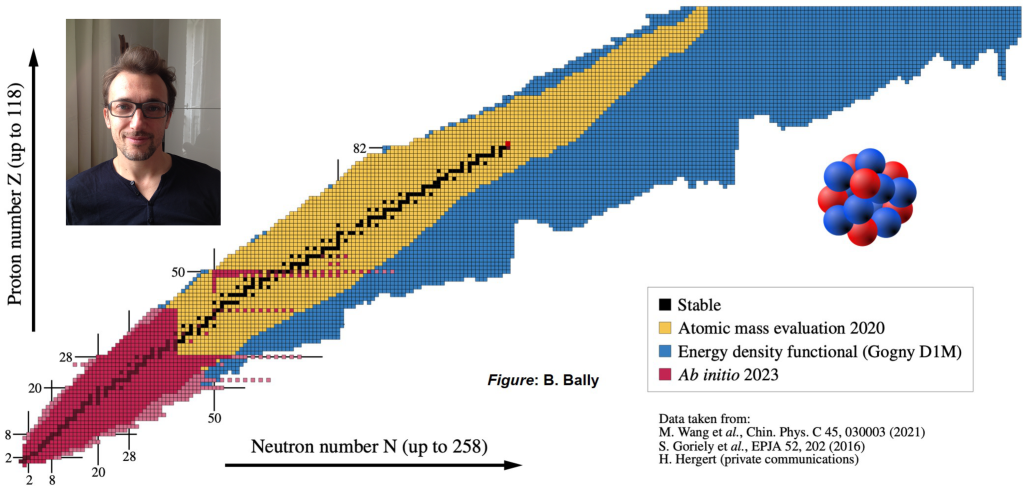
In low-energy nuclear physics, the “ab initio” theoretical scheme aims at describing nuclear systems as made of A=N+Z effective structure-less and color-less nucleons interacting via the residual of the strong force between them. The two main difficulties in such an approach consist of (i) generating a systematic modelling of inter-nucleon interactions and of (ii) obtaining a controlled solution of A-body Schrödinger’s equation independently of the type and or mass of the nucleus under consideration. Recently, considerable progress has been made in both directions, with realistic ab initio calculations reaching out to a significant fraction of existing nuclei. I will give a personal account of these advances (biased towards finite nuclei and structure properties) as well as of the challenges that remain ahead of us.
Monday, 13/02 (15h, CET)
Energy traps in atomic nuclei
Philip Walker (University of Surrey, UK)
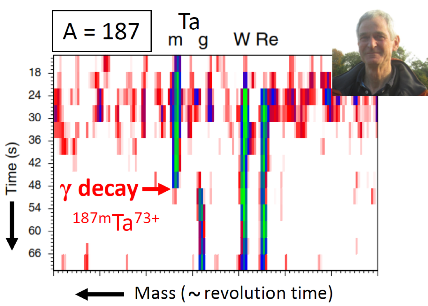
Atomic nuclei can store huge amounts of energy in excited “isomeric” states. How is this possible? What do such states teach us about nuclear structure? Can the stored energy be useful? This talk addresses these issues, starting with the discovery of isomers 100 years ago. Since the early days, isomers have made key contributions to the development of nuclear structure models, and nowadays isomers provide anchor points in the study of exotic nuclei, far from the valley of beta stability. Applications of isomers range from astrophysics to medical imaging. Emerging opportunities will be discussed, with a focus on the possibility of the controlled release of the stored energy of isomers.
Further reading: “100 years of nuclear isomers – then and now”, P.M. Walker and Zs. Podolyák, Phys. Scr. 95 (2020) 044004.
2022
Monday, 12/12 (16h, CET): hosted by GdR RESANET
Nuclear reactions at heavy-ion storage rings,
Beatriz JURADO (LP2I, Bordeaux).

Obtaining reliable cross sections for neutron-induced reactions on unstable nuclei is crucial to our understanding of the stellar nucleosynthesis of heavy elements and for applications in nuclear technology. However, the measurement of these cross sections is very complicated, or even impossible, due to the radioactivity of the targets involved. The NECTAR (NuclEar reaCTions At storage Rings) project aims to circumvent this problem by using the surrogate-reaction method in inverse kinematics at heavy-ion storage rings, which offer unique and largely unexplored possibilities for the study of nuclear reactions. In this talk, I will present the technical developments and the methodology, which we are developing within NECTAR to perform high-precision surrogate-reaction experiments at the heavy-ion storage rings of the GSI/FAIR facility. In particular, I will present the first results of the proof of principle experiment, which we successfully conducted in June 2022 at the ESR storage ring of GSI/FAIR.
pdf of the talk.
Monday, 14/11 (16h, CET): hosted by GdR RESANET
From nuclear medicine to nuclear astrophysics,
Ulli KÖSTER (ILL Grenoble)
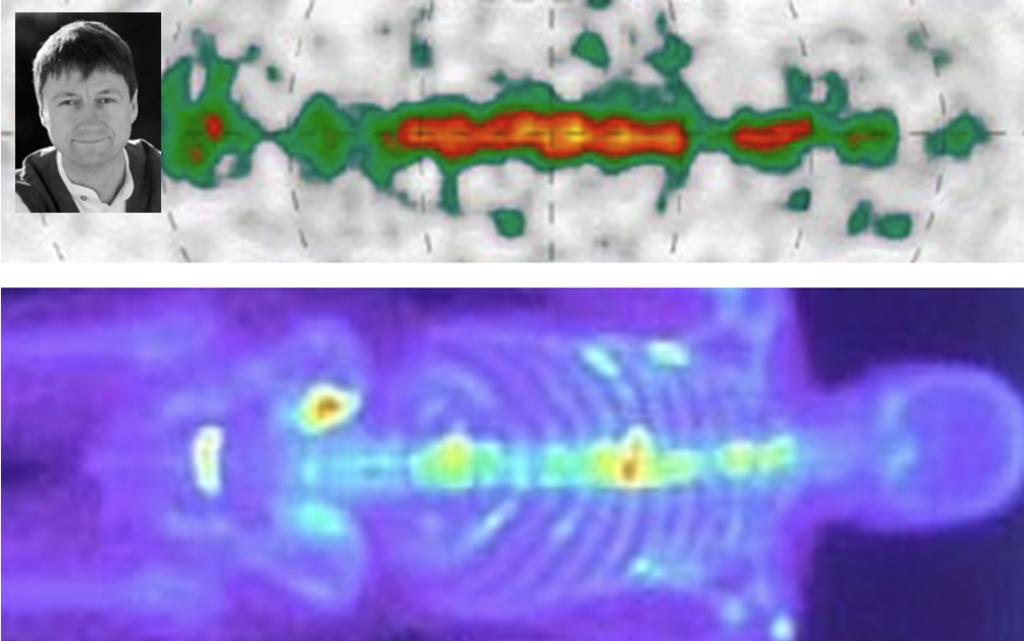
Nuclear astrophysics and nuclear medicine are two very different fields of “applied nuclear physics” where nuclear reactions and radionuclides play an essential role. However, not only the location, but also the involved energies and time-scales are usually extremely different. Nonetheless, some interesting parallels can be drawn between both fields. I am going to discuss established and novel radionuclides and techniques that are being employed in nuclear medicine and provide links to their relevance in nuclear astrophysics respectively.
Monday, 24/10 (16h, CET): hosted by GdR RESANET
How does subatomic matter organize itself?
Xavier Roca-Maza (Univ. Milano and INFN)
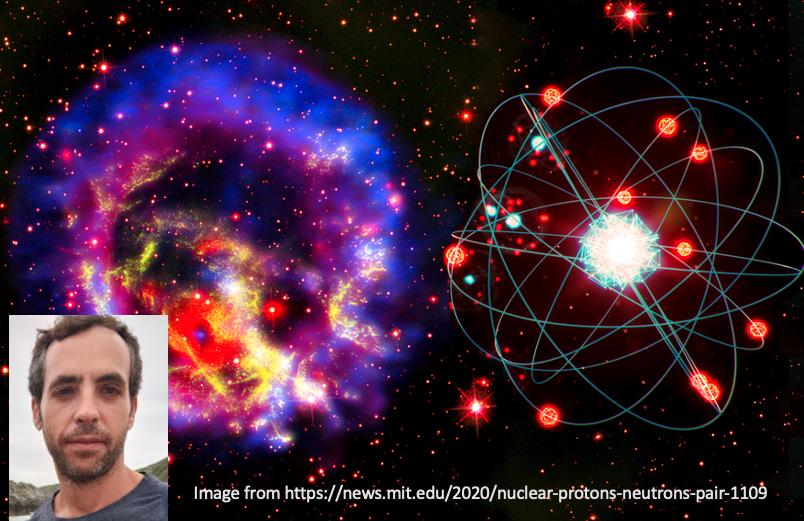
I will briefly introduce the strong synergy between “heaven and earth” which is instrumental in the study of the nuclear Equation of State. That is, the relevance of ground experiments as well as accurate astronomical observations on neutron stars and gravitational waves to shed light into one of the most challenging problems of our times: how does subatomic matter organize itself. New avenues recently fostered by the Milano group to deal with the nuclear many-body problem will be also presented.
pdf of the talk.
Monday, 25/04 (16h, CET): hosted by GdR RESANET
Probing nuclear superfluidity and superconductivity with neutron stars,
Nicolas CHAMEL (IAA, ULB Bruxelles)
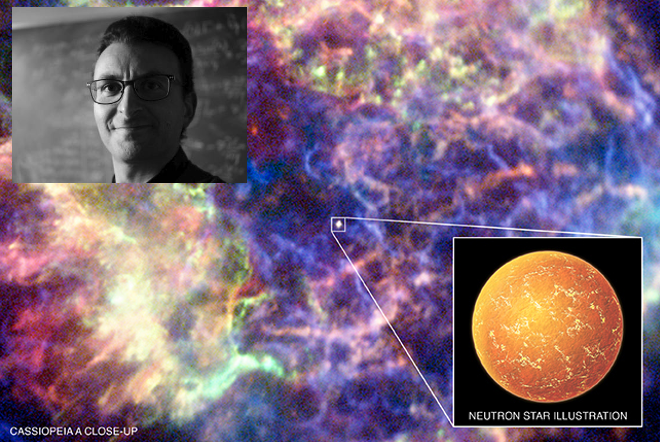
Formed in the furnace of gravitational core-collapse supernova explosions, neutron stars contain matter crushed at densities exceeding that found inside the heaviest atomic nuclei. Despite typical temperatures of order ten million degrees, the extremely dense matter in neutron stars is expected to be cold enough for the appearance of superfluids and superconductors – frictionless quantum liquids respectively electrically neutral and charged – made of neutrons and protons, and more speculatively of other particles such as hyperons or even deconfined quarks. If these phase transitions really occur, neutron stars would not only be the largest superfluid and superconducting systems known in the Universe, but also the hottest ones with critical temperatures reaching ten billion degrees. After describing the main properties of terrestrial superfluids and superconductors, our current understanding of analogous phenomena in neutron stars will be reviewed together with their astrophysical manifestations.
pdf of the talk.
Monday, 24/01 (16h, CET): hosted by GdR RESANET
Angular momentum generation in nuclear fission,
Jon N. WILSON (IJCLab Orsay)
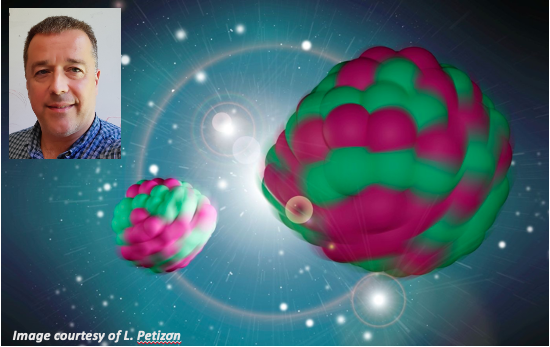
When a heavy atomic nucleus fissions, the resulting fragments are observed to emerge spinning [1]; this phenomenon has been an outstanding mystery in nuclear physics for a long time. The internal generation of around 6-7 units of angular momentum in each fragment is particularly puzzling for systems which start with zero, or almost zero, spin.
Over the last 5 decades much experimental and theoretical effort has been devoted to understanding the fission mechanism and questions such as angular momentum generation, energy partition between fragments and neutron emission. In this presentation I will review this body of research and look particularly in detail at current efforts, including very recent experimental results [2,3] and related theoretical works [4,5,6] which attempt to better understand this fascinating phenomenon. This research is not only important for the fundamental understanding and theoretical description of fission, but also has consequences for the γ-ray heating problem in nuclear reactors, for the study of the structure of neutron-rich isotopes, and for the synthesis and stability of super-heavy elements.
[1] J. B. Wilhelmy, Phys. Rev. C 5 2041 (1972)
[2] J.N. Wilson et al., Nature 590 566 (2021)
[3] M. Travar et al. Phys. Lett. B 817 136293 (2021)
[4] J. Randrup and R. Vogt, Phys. Rev. Lett. 127 062502 (2021)
[5] P. Marevic et al., Phys. Rev. C104, L021601 (2021)
[6] I. Stetcu et al., Phys. Rev. Lett. 127 222502 (2021)
The pdf of the talk can be find here.
Organizers: F. Arleo (SUBATECH Nantes), P. Ascher (CENBG Bordeaux), O. Dorvaux (IPHC Strasbourg), J. Dudouet (IP2I Lyon), A. Fantina (GANIL Caen), G. Henning (IPHC Strasbourg), A. Korichi (IJCLab Orsay), O. Lopez (LPC Caen), J. Margueron (IP2I Lyon), G. Quemener (LPC Caen), O. Sorlin (GANIL Caen), B. Sulignano (IRFU Saclay), J.-C. Thomas (GANIL Caen), L. Thulliez (IRFU Saclay), A. Uras (IP2I Lyon), M. Vandebrouck (IRFU Saclay), P. Van Hove (IPHC Strasbourg), G. Verde (L2IT Toulouse).
2021
Monday, 22/11 (16h, CET): hosted by RESANET
Properties of exotic nuclei revealed by laser spectroscopy,
Michael BLOCK (GSI Darmstadt)
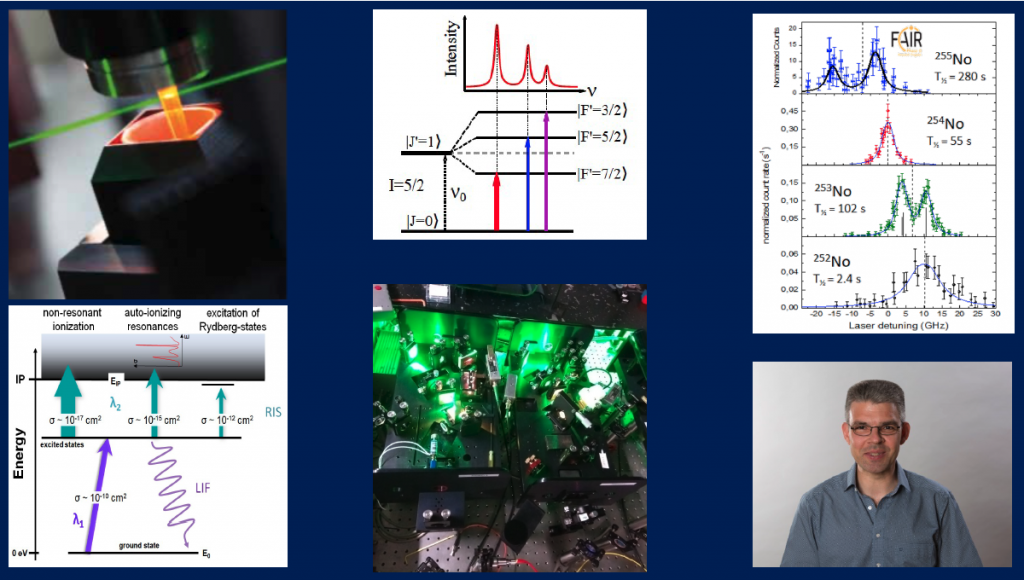
Laser spectroscopy provides an experimental route to determine nuclear properties using an electron in the atomic shell as a sensitive probe. For example, from the isotope shift of an atomic transition reflects changes in the mean-square charge radius of the nucleus. The hyperfine splitting of an atomic transition carries information on the nuclear spin and allow us to determine electromagnetic nuclear moments that provide information on the nuclear deformation and configuration. It is of particular interest to perform such measurements in exotic nuclei far from stability where the nuclear structure changes compared to stable nuclei and new phenomena may occur. However, laser spectroscopy of exotic nuclides is challenging since they have to be produced at accelerator facilities resulting in small yields, short half-lives, and the undesired formation of by-products than may limit laser spectroscopy. However, significant progress in laser spectroscopy has been made thanks to a continuous development of novel methods and the construction of tailor-made setups. Nowadays we can access radionuclides of essentially all elements, even the heaviest elements well above uranium. In my presentation I will introduce some of the most common methods employed for laser spectroscopy of radionuclides and will present a few representative recent examples of results obtained at different facilities.
Monday, 08/11 (16h, CET): hosted by RESANET
New frontiers in nuclear physics and nuclear astrophysics,
Iulian Stephan (IJCLab Orsay) and Stephane Grévy (CENBG Bordeaux)
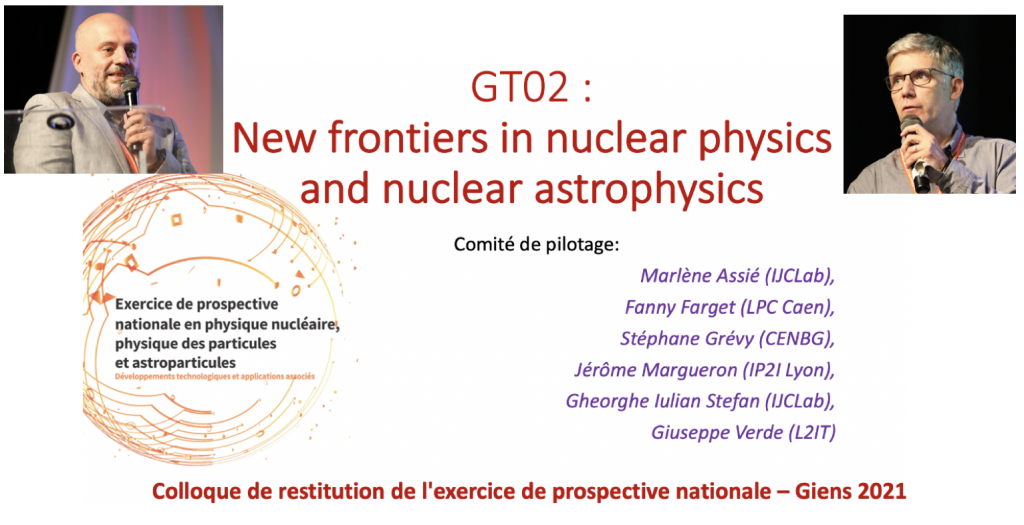
Le colloque de restitution des prospectives nationales en physique nucléaire, des particules, astroparticules, technologies et applications associées. s’est déroulé à Giens du 19 au 22 octobre avec pour objectif de présenter les travaux des 13 groupes de travail et préparer la feuille de route 2020-2030 de l’IN2P3. Durant ce webinaire, nous vous proposons de vous présenter les deux exposés du GT02, Physique Nucléaire et Astrophysique Nucléaire. Le premier avait pour objectif de présenter nos sciences drivers « New Frontiers in nuclear physics and nuclear astrophysics » par Iulian Stefan, tandis que le second avait pour objectif de présenter les développements des installations nationales et les projets associés « Facility developments, technical projects and associated recommandation » par Stéphane Grévy.
Monday, 25/10 (16h, CET): vacation break
Monday, 11/10 (16h, CET): hosted by GdR RESANET
A short History of Nuclear Astrophysics: Part II: The origin of the elements
Nikos PRANTZOS (IAP Paris)
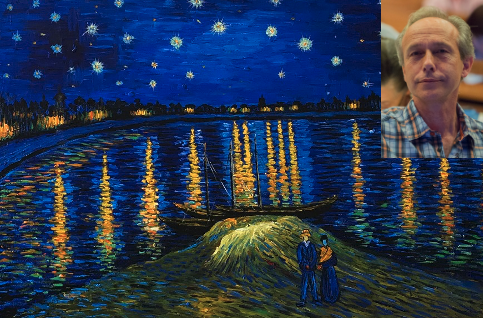
I will present the second part of this Short history of Nuclear astrophysics, showing how the debate oscillated in the 1930ies and 1940ies between a primordial and a stellar origin of the chemical elements in the Universe. The former was promoted mainly by George Gamow and the latter by Fred Hoyle. The debate was settled in the mid-1950ies, after Burbidge, Burbidge, Fowler and Hoyle established the – rather long – list of nuclear processes that produce the majority of elements inside stars. However, more than 60 years later, several aspects of this ambitious project remain poorly understood yet.
The pdf of the talk is here.
Monday, 13/09 (16h, CET): hosted by GdR RESANET
Towards super heavy elements in France!
Barbara SULIGNANO (IRFU Saclay)

The ambitious scientific program to produce and study super heavy nuclei or neutron deficient nuclei close to the proton drip-line via fusion evaporation has led to the development of a new separator spectrometer: S3. The Super Separator Spectrometer (S3) facility is developed in the framework of the SPIRAL2 project. S3 has been designed to perform experiments with extremely low cross sections, taking advantage of the very high intensity stable beams of the superconducting linear accelerator of SPIRAL2.
The development of S3 has required to overcome multiple technological challenges: the construction of a powerful recoil separator with high mass resolution and large transmission capabilities; a high efficiency detection systems; a target able to support the high intense heavy ion-beams needed to access very low cross section reactions (picobarn). S3 is now in its final phase of construction and will soon be operational. In parallel, SIRIUS, a new focal plane detector has been developed, in order to detect rare ions such as super heavy elements.
In this talk will be presented the status of the project, the comparison with the different world laboratories where the production of super heavy elements is now possible and the physics intended to be performed in the next future.
The pdf of the talk is here.
Monday, 05/07 (16h, CET): hosted by GdR RESANET
Description of complex quantum systems with quantum computers,
Denis LACROIX (IJCLab Orsay)
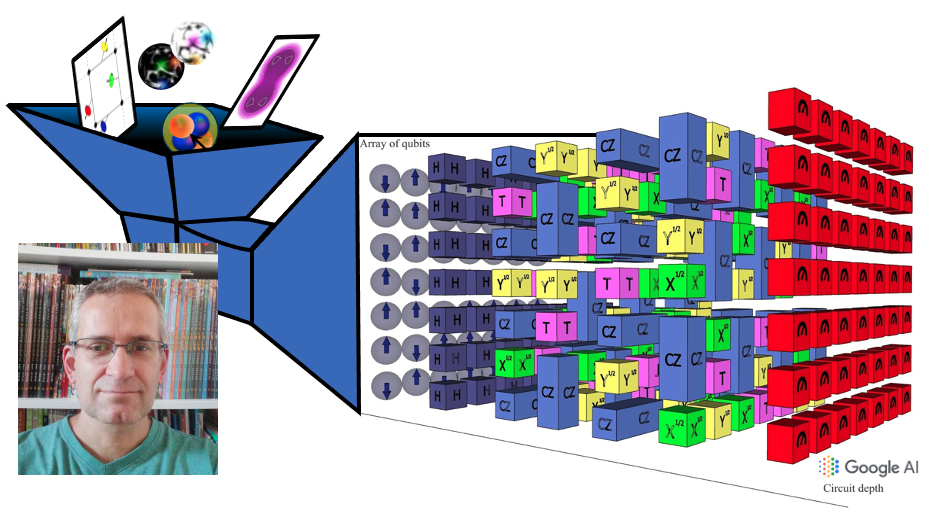
With the arrival of the first quantum computer demonstrators, such as those developed by IBM or Google, the field of quantum computing (QC) is rapidly gaining interest and visibility. Programming on such quantum computer prototypes is still a formidable challenge, especially since they represent a disruptive technology, as widely expected. In the first part of my talk, I will make a very general introduction on quantum computing. The notion of qubits, quantum gates and circuits as well as the entanglement will be discussed. I will also briefly summarize the recent progress in quantum computer technologies and associated quantum processor units. Some resources for beginners on QC can be found at the QC2I project webpage [1].
In the second part of my talks, I will give examples of recent applications on the problem of interacting particles that could be relevant not only for nuclear physics but also for other fields of physics and chemistry. I will show how superfluid systems can be encoded on a quantum computer. Two aspects will be discussed (i) the possibility to break and restore symmetries in QC [2] and (ii) the possibility to predicts eigenstates and long-time evolution from short time simulation on quantum computers [3].
The pdf of the talk is here.
[1] QC2I (quantum computing for the two infinities) https://qc.pages.in2p3.fr/web/
[2] Denis Lacroix, “Symmetry-Assisted Preparation of Entangled Many-Body States on a Quantum Computer”, Phys. Rev. Lett. 125, 230502 (2020).
[3] Edgar-Andres Ruiz-Guzman and Denis Lacroix, “Predicting ground state, excited states and long-time evolution of many-body systems from short-time evolution on a quantum computer”, arxiv: 2104.08181
Monday, 21/06 (16h, CET): hosted by GdR RESANET
A short History of Nuclear Astrophysics: Part I: The Energy of Stars
Nikos PRANTZOS (IAP Paris)
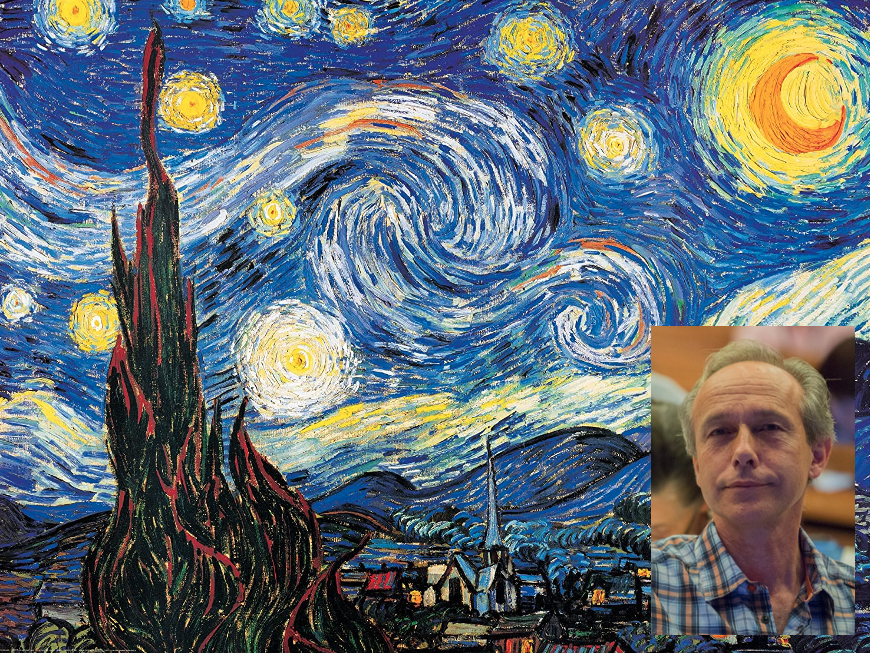
I will present an overview of the development of nuclear astrophysics, from its beginnings in the late 1920s, till its maturation in the late 1960s. Nuclear astrophysics emerged from the « marriage » of the old science of astronomy with the young discipline of nuclear physics, with a twofold objective: to understand the energy of the Sun and stars and the origin of the chemical elements in the Universe. Its development is intimately connected to the development of particle physics during its early period. Its history is the result of the work of some of the greatest physicists of the 20th century and it was crowned by two Nobel prizes. In the first part I will present our progressive understanding of the source of stellar energy, which was completed in the late 1930s.
In an era of evergrowing specialisation in all scientific disciplines, it is useful for students and scientists alike to gain an elementary knowledge of the history of ideas and of their development in the socio-cultural and technological context of their epoch.
The pdf of the talk is here.
Monday, 07/06 (16h, CET): hosted by GdR RESANET
New insights into fission from recent experiments: What drives fission across the nuclear chart?
Christelle SCHMITT (IPHC Strasbourg)
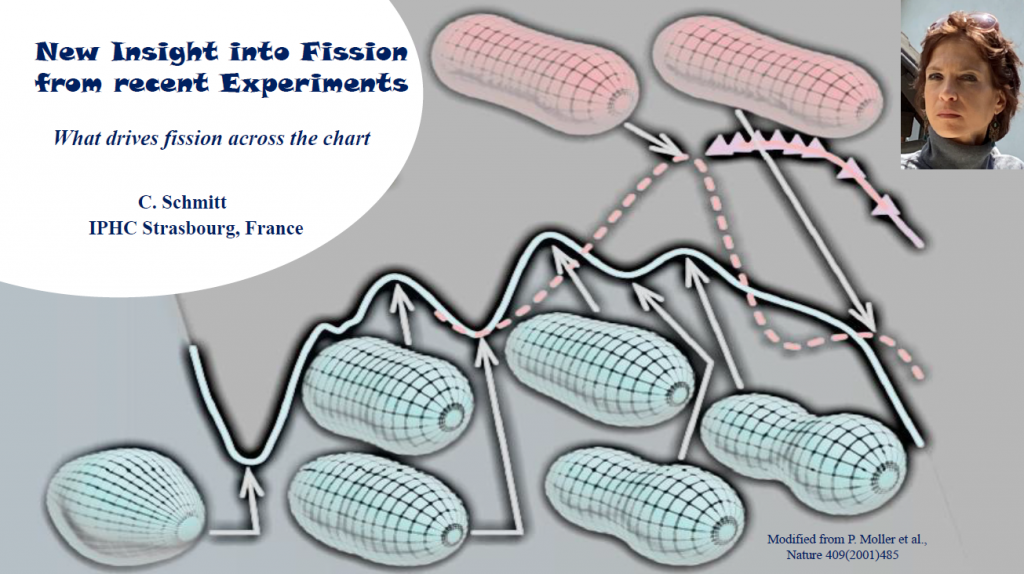
Nuclear fission owes its name by the fact that it resembles the division of living cells. But hidden behind is the complex re-arrangement of a many-body quantum system involving two types of nucleons, the protons and the neutrons. As a consequence, the process revealed to be a rich laboratory for studying fundamental nuclear properties, in general, and dynamical aspects of nuclear reactions, in particular. The importance of fission in astrophysics and for a wide variety of societal applications is established also.
Several probes have been proposed to study fission. In this presentation, we focus on the characterization of the fission-fragment products in terms of mass, charge and energy, and on their de-excitation. Recent experimental advances in the region of actinides and neutron- deficient lead are used to demonstrate the step forward in the field made from most accurate measurements. A consistent analysis of the information collected during the last years shows that the protons – which importance was overlooked so far, are key drivers of fission over the nuclear chart. A brief discussion of state-of-the-art models is finally proposed, emphasizing the necessary theoretical development regarding the dynamical transition from a fissioning-system- to a nascent-fragment-driven process.
The pdf of the talk is here.
Monday, 10/05 (16h, CET): hosted by GdR RESANET
Search for new physics beyond the Standard Model with precision measurements in nuclear beta decays,
Etienne LIENARD (LPC Caen)
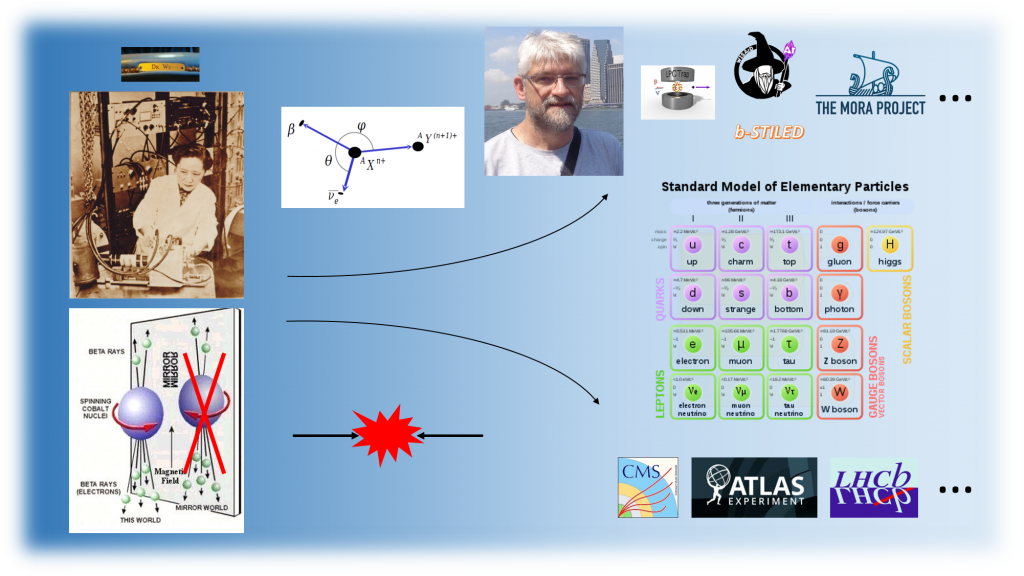
Precision measurements in nuclear beta decays provide sensitive tools to test the foundations and symmetries of the Standard electroweak Model and to search for exotic couplings presently excluded by the V-A theory in processes involving the lightest quarks. The main aim of such measurements is to highlight deviations from the Standard Model predictions as possible indications of new physics, complementing other searches at large-scale facilities such as the LHC. The sensitive parameters are often deduced from correlation studies between the very few bodies involved in the decay. This requires to perform very precise measurements using advanced technical methods, such as ion or atom traps installed on-line in radioactive nuclei production facilities. Data analysis also requires generating the most realistic simulations to take into account the relevant parameters of the experimental setup and their systematic effects on the measured quantities.
In this seminar, I will present different experimental projects in which LPC Caen is involved, starting from the development of LPCTrap at GANIL to search for exotic tensor currents in the decay of 6 He 1+ ions. This pioneer experiment laid the foundations of our present projects, not only in the search for exotic currents (WISArD, b-STILED), but also with other perspectives comprising the test of CVC from the study of mirror transitions and the quest for new sources of CP violation (MORA) needed to explain the large matter-antimatter asymmetry observed in the universe. The status and goals of these projects will be discussed.
The pdf of the talk is here.
Monday, 26/04 (16h, CET): hosted by CENBG
Precision mass measurements for nuclear and neutrino physics studies
Klaus BLAUM (Max-Planck-Institut für Kernphysik, Heidelberg)
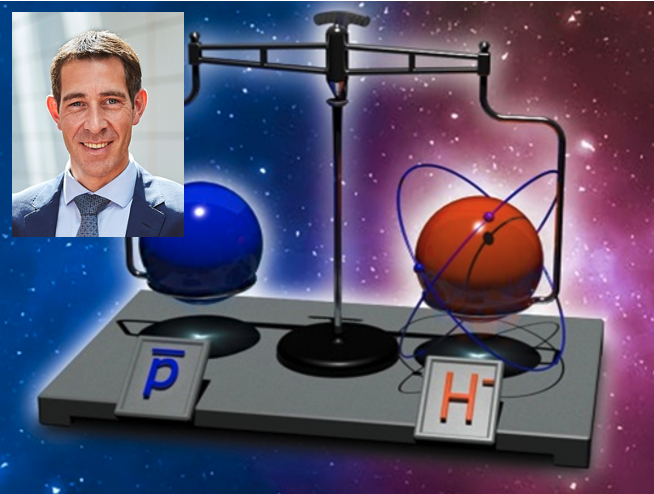
Rapidly developing neutrino physics has found in Penning-trap mass spectrometry a staunch ally in investigating and contributing to a variety of fundamental problems. The most familiar are the absolute neutrino mass and the possible existence of resonant neutrinoless double-electron capture / double-beta dacay and of keV-sterile neutrinos. This review provides an overview on the latest achievements and future perspectives of Penning-trap mass spectrometry on short-lived as well as stable nuclides with applications in nuclear structure, neutrino physics and most recently even in dark matter searches where relative mass uncertainties at the level of 10-11 and below are required.
The pdf of the talk is here.
Monday, 12/04 (16h, CET):
From nuclei to neutron stars: Combining nuclear physics and multi-messenger observations
Ingo TEWS (Los Alamos National Laboratory, USA)

Neutron stars contain the largest reservoirs of degenerate fermions, reaching the highest densities we can observe in the cosmos, and probe matter under conditions that cannot be recreated in terrestrial experiments. Throughout the Universe, a large number of high-energy, cataclysmic astrophysical collisions of neutron stars are continuously occurring. These collisions provide an excellent testbed to probe the properties of matter at densities exceeding the density inside atomic nuclei, are an important site for the production of elements heavier than iron, and allow for an independent measurement of the expansion rate of our Universe.
To understand these remarkable events, reliable nuclear-physics input is essential. In this colloquium, I will review how to use state-of-the-art nuclear-physics calculations to provide a consistent and systematic approach to strongly interacting systems from nuclei to neutron stars with theoretical uncertainties. I will discuss nuclear-physics predictions for the dense nucleonic matter relevant for neutron stars, and discuss how astrophysical multi-messenger observations of neutron stars and their mergers can be used to further elucidate the properties of matter under extreme conditions.
The pdf of the talk is here. LA-UR-21-23129
Monday, 29/03 (16h, CET): hosted by GdR RESANET
Selected topics on heavy and super-heavy nuclei,
Christophe THEISEN (DPhN Saclay)
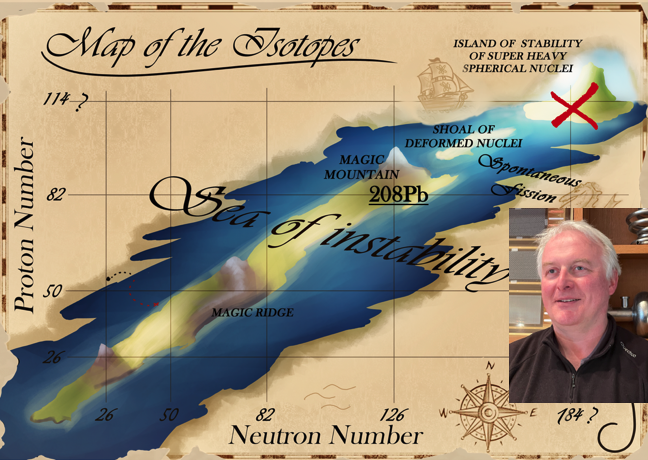
In this webinar I will review selected aspects of heavy and superheavy nuclei, starting from the discovery of transactinide nuclei in the 40th using neutron « beams ». Then, still with neutrons, I will continue with the question of the superheavy nuclei nucleosynthesis in the r-process: supernovae explosions, neutron star mergers, collapsars. These nucleosynthesis processes are strongly constrained by nuclear structure, and in particular by the fission barriers, for nuclei where no experimental data can be obtained. I will therefore discuss theoretical predictions, both for spherical magic and deformed regions. We will see how we can obtain experimentally information on not-too-heavy nuclei near the deformed shell gap Z=100 N=152. How can we deduce and in some cases measure the deformation or the electric quadrupole moment of the heaviest nuclei (spectroscopy, coulex, laser spectroscopy)? I will also discuss the theoretical difficulties and problems faced in this region. I will conclude with few flagship experimental projects such as S3 and the future NEWGAIN injector at GANIL, the possibility of re-accelerating actinide nuclei, and the synthesis using multi-nucleon transfer reactions.
The pdf of the talk is here.
Monday, 15/03 (16h, CET): hosted by GdR RESANET
On the tracks of two-proton radioactivity,
Jérôme GIOVINAZZO (CENBG Bordeaux)
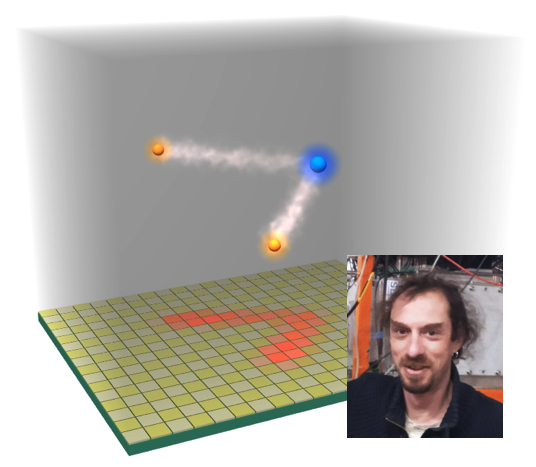
The two-proton radioactivity is a very exotic decay mode that can occur for very neutron deficient nuclei located beyond proton drip-line. From theoretical assumptions, it was already predicted in the early 1960’, together with the one-proton radioactivity. Nevertheless, it is only in the years 2000 that a first experimental indication of the phenomenon could be observed, thanks to the development of the facilities that can produce nuclei far from stability.
This process is made possible thanks to very specific quantum effects at the microscopic level: the Coulomb barrier originating in the electric charge of all protons in the nucleus and the gain of stability caused by the coupling of nucleons in pairs. It has been observed in the decay of only 4 nuclei, and 20 years after the first observation, in order to understand this radioactivity, new experimental tools are built to measure the correlations of the protons, and theoretical models are developed to describe both the structure of the emitting nuclei and the dynamics of the emission.
In this presentation will give a brief description of this exotic decay process and explain the major steps of its study, from both theoretical and experimental sides.
The pdf of the talk is here.
Organizers: F. Arleo (SUBATECH Nantes), P. Ascher (CENBG Bordeaux), O. Dorvaux (IPHC Strasbourg), S. Diglio (SUBATECH Nantes), J. Dudouet (IP2I Lyon), A. Fantina (GANIL Caen), G. Henning (IPHC Strasbourg), A. Korichi (IJCLab Orsay), O. Lopez (LPC Caen), J. Margueron (IP2I Lyon), G. Quemener (LPC Caen), O. Sorlin (GANIL Caen), B. Sulignano (IRFU Saclay), J.-C. Thomas (GANIL Caen), L. Thulliez (IRFU Saclay), A. Uras (IP2I Lyon), M. Vandebrouck (IRFU Saclay), P. Van Hove (IPHC Strasbourg), G. Verde (L2IT Toulouse).
2020
Monday 14/12 (16h):
Nucleosynthesis: new perspectives from gamma-ray astronomy
Vincent TATISCHEFF, IJCLab Orsay
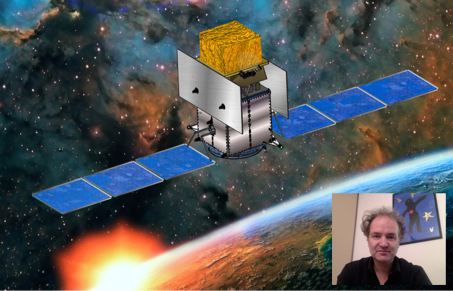
Measurements of gamma-ray photons from cosmic sources of nuclear radiation have advanced our knowledge of the origin of the chemical elements. Many isotopes are synthesized in exploding stars – novae, supernovae, kilonovae –, some of which are radioactive and emit specific gamma-ray lines that can be detected by space telescopes. Radioisotopes with a relatively short lifetime can be used to directly characterize the individual explosion events or the first stages of the stellar remnant, while long-lived radioactivites, with lifetimes much longer than the characteristic time between events that synthesize them, can produce a diffuse gamma-ray emission in the sky. Observations in the MeV gamma-ray band offer a privileged diagnostic tool with respect to other measurements based on atomic spectroscopy, thanks to the penetration power of high-energy photons and the association of gamma-lines to specific isotopes. In this colloquium, I will review the progress made in recent years in our understanding of nucleosynthesis thanks to some remarkable gamma-ray observations, and then discuss the prospects that a new, more sensitive gamma-ray space observatory could offer us.
The pdf of the talk is here.
Monday 07/12 (16h):
Sixty years of multineutron quest: game over or game on?
Miguel MARQUÉS, LPC Caen
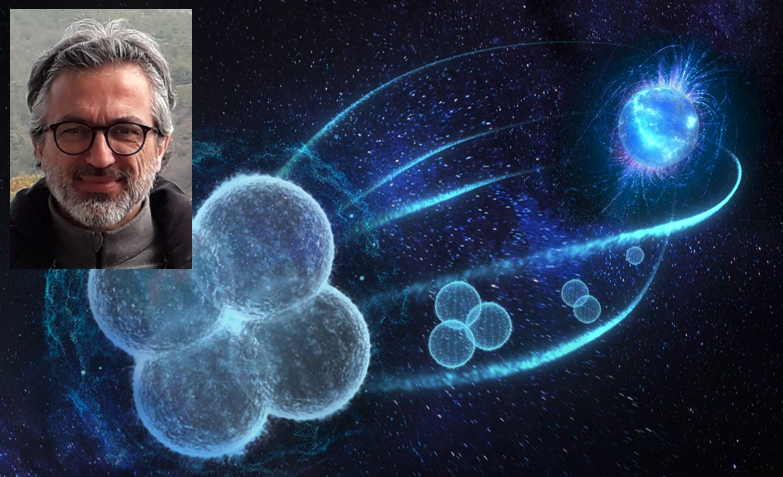
Already in the early 1960s, when physicists started to move away from the valley of stability, some crazy ones tried to create « neutral nuclei » in their laboratories. They didn’t succeed, but the task was a very difficult (while fascinating) one, both from the construction and the detection points of view. Fascination overcame difficulty and other physicists kept trying to find these objects, that would defy nuclear theory as we know it, all through the XX century. Finally, in this XXI century two signals of a possible tetraneutron state close to threshold were obtained, first at GANIL and then at RIKEN, that were weak but have not been contested yet. They have triggered a lot of new theoretical calculations, as well as new generation experiments that try to reveal something that has eluded firm evidence for sixty years already. I will review some of the most exotic experiments, highlight their merits and drawbacks, and show why the present ones think they will succeed where so many others have failed. The game might be over soon, whatever the outcome!
The pdf of the talk is here.
Monday 30/11 (16h):
150 years of the periodic table – from a nuclear physics perspective,
Araceli LOPEZ-MARTENS, IJCLab Orsay
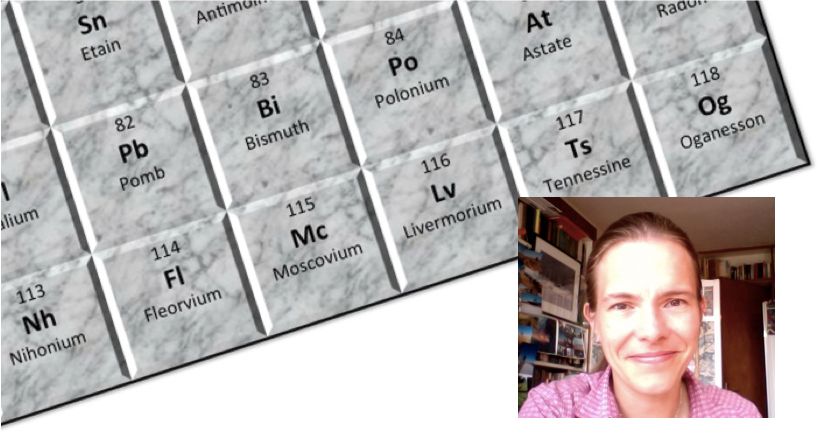
At the dawn of the 20th century, most scientists believed that matter was made up of atoms and that what distinguished the atoms of different elements was their mass. It was this mass that was used to classify the elements. The chemists of the time quickly became aware of periodicities in the chemical behaviour of certain elements that they tried to translate into tables, the most famous of which was that of the Russian chemist Dmitri Mendeleev. In Mendeleev’s table, the elements were arranged by increasing atomic mass, some cells were left empty and the position of the elements was given by the letter Z, from the German word zahl (number). In this colloquium, I will show how discoveries in nuclear physics have transformed our understanding of the atom, how they have given its true meaning to the periodic table and how they have completed the 7 periods of the periodic table up to the last known element: oganesson.
The pdf of the talk is here.
Organizers: O. Dorvaux (IPHC Strasbourg), J. Dudouet (IP2I Lyon), A. Korichi (IJCLab Orsay), A. Fantina (GANIL Caen), O. Lopez (LPC Caen), J. Margueron (IP2I Lyon), O. Sorlin (GANIL Caen), J.-C. Thomas (GANIL Caen), M. Vandebrouck (IRFU Saclay), G. Verde (L2IT Toulouse).
